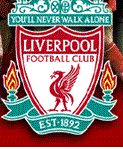

Stadium Information
Contacts
To contact Liverpool FC, write to:
Liverpool Football Club Anfield Road Liverpool Merseyside L4 OTH
To contact the club by telephone:General Enquiries:
+44 (0)151 263 2361(phone): +44 (0)151 260 8680
(fax): +44 (0)151 261 1416
24 Hr Information Service:
+44 (0)151 260 9999Match Ticket Credit Card Bookings:
+44 (0)151 263 5727Kop Grandstand
(phone):
+44 (0)151 263 1760(fax):
+44 (0)151 264 9088Opening Times: Monday - Friday Saturdays Sundays Match Saturdays Match Sundays Match Evenings 9.00am - 5.00pm 9.00am - 4.30pm 10.00am - 4.00pm 9.00am - 45 mins after game 10.00am - 45 mins after game 9.00am - 45 mins after game
11 Williamson Square Liverpool L1 1EQ
(phone):
+44 (0)151 330 3077Opening Times: Monday - Saturday Sundays 9.00am - 5.30pm 11.00am - 5.00pm
+44(0)151 263 6391
(e-mail):
devassoc@liverpoolfc.net+44(0)151 263 7744
+44(0)151 261 1444
+44 (0)151 263 9199
+44 (0)151 260 1433
+44 (0)151 263 2361
(e-mail):
reducate@liverpoolfc.net+44 (0)151 260 1515
Anfield
and Centre: +44 (0)151 260 6677Museum and Tour:
Adults £8.50, Under 16 and OAP £5.50, Family (2 Adult - 2 Child) £23 Museum Only: Adults £5, Under 16 and OAP £3, Family (2 Adult - 2 Child) £13Capacity: 45,362
Pitch Size: 101x79 metresHighest Attendance
61,905 vs Wolves (FA Cup, 4th Round), 2nd Feb. 1952
Training Ground
Youth Development
Facts And Figures
Records
Most Capped Player
Kenny Dalglish 102 (Scotland)Most League Appearances
Ian Callaghan 640 (1960-78)Overall Record Scorer
Ian Rush 335Overall Record League Scorer
Roger Hunt 245 (1959-1969)Highest League Season Scorer
Roger Hunt 41, Div. 2 (1961-62)Record League Victory
10-1 vs. Rotherham Town (Div. 2), 18th Feb. 1896Record Cup Victory
11-0 vs. Stromgodset Drammen (European Cup Winners' Cup, 1st Round 1st Leg), 17th Sept. 1974Record Transfer Fee Paid
£11.0m for Emile Heskey (Leicester)Record Transfer Fee Received
£7.0m for Stan Collymore (Aston Villa)Honours
League Champions
18FA Cup Winners
5League Cup Winners
5Charity Shield Winners
13European Cup Winners
4UEFA Cup Winners
2European Super Cup Winners
1
A Brief History

The story begins in 1878 with the formation of St Domingo's Football Club, organised around the sporting activities of a local chapel. Football was becoming so popular at the time that St Domingo's decided to increase its catchment area, and in 1879 adopted the more impressive name of Everton Football Club. Five years later, Everton began playing their home games at Anfield. The owner of the ground was a wealthy businessman and future Mayor of Liverpool, John Houlding, whose power and influence in the area was reflected in his nickname "King John of Everton". The name of Everton therefore crops up in the early history of Liverpool, because it was not until 1892 that Liverpool Football Club was formed. March 1892 was a crucial month. A financial dispute involving Houlding and fellow members of Everton over the tenancy of the ground finally reached a point of no return, resulting in a decision to move Everton Football Club to new premises across Stanley Park. Houlding was thus left with a football ground, but no team to play on it. W.E. Barclay, Houlding's friend and fellow football fanatic, suggested that a new team be created. Houlding liked the idea so Liverpool Association Football Club (as the club was originally known) was born. Houlding applied immediately for the membership of the Football League but when his application was rejected Liverpool had to settle for a season in the more local Lancashire League. It was virtually unheard of at the time for a city to have more than one professional football team, and people naturally wondered where on earth Liverpool's players would come from. John McKenna, the club's first manager provided the answer; Scotland. All eleven players of the Liverpool team that played it's first ever competitive match, against Higher Walton on the 3rd September 1892, were Scottish. In the 1893-94 season, L.F.C. was promoted to the Second Division after only one season. Liverpool's first ever League game was away to the now defunct Middlesbrough Ironopolis, with Malcom McVean earning the historic accolade of scoring Liverpool's first ever League goal, in a 2-0 victory. During the following season home gates were approaching 20,000, after very humble beginnings. The 1898-99 season saw the arrival of the centre-half Alex Raisbeck, Liverpool's first real world-class player to wear the famous red strip (which replaced the original blue and white colours in 1896). In the 1900-01 season, as Queen Victoria's lengthy reign drew to a close, Liverpool won the League Championship for the first time. This was to be the first championship victory of many. Currently the 18 championship victories constitute a record for any English Club.
Present Day
Since those days, Liverpool Football Club has developed into what is now one of the worlds leading football clubs. Anfield has become a magnificent stadium and was chosen to host matches in the 1996 European Nations Cup. Whilst the Welsh F.A. temporarily lost the use of the National Stadium in Cardiff due to re-furbishment, the Club was given the honour of hosting Wales v Italy in the 2000 European Nations Cup qualifying matches. The stadium has a capacity of 45,000 which makes Anfield the second largest Club ground in England. Any visitors to the ground are welcome to visit the Club's Museum which may, if required, incorporate a visit around the world famous stadium. Fans both young and old will find something to interest them in the interactive enviroment. Overseas visitors or students who are researching the Club and its history will find the Museum & Tour Centre most useful. Also available at our Club Shop, which is situated within the stadium complex, is a range of books and videos, which may be of assistance as points of reference.